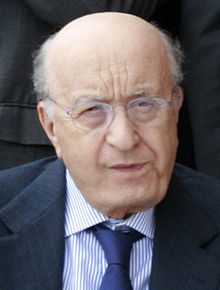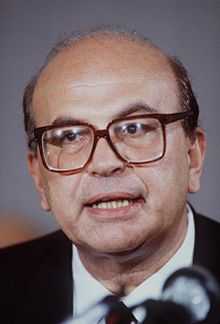Italian general election, 1983
Italian general election, 1983

|
|
|
|
|

|
| Legislative election results map. Light Blue denotes provinces with a Christian Democratic plurality, Red denotes those with a Communist plurality, Gray and Brown denotes those with an Autonomist plurality. |
|
General elections were held in Italy on June 26, 1983.[1] The Pentaparty formula, the governative alliance between five centrist parties, caused unexpected problems to Christian Democracy. The alliance was fixed and universal, extended both to the national government and to the local administrations. Considering that the election result did not longer depend by the strength of the DC, but by the strength of the entire Pentaparty, centrist electors began to look at the Christian Democratic vote as not necessary to prevent a Communist success. More, voting for one of the four minor parties of the alliance was seen as a form of moderate protest against the government without giving advantages to the PCI. Other minor effects of this election were a reduction of the referendarian Radical Party and the appearance of some regional forces.
Electoral system

Regional pluralities in Senate
The pure party-list proportional representation had traditionally become the electoral system for the Chamber of Deputies. Italian provinces were united in 32 constituencies, each electing a group of candidates. At constituency level, seats were divided between open lists using the largest remainder method with Imperiali quota. Remaining votes and seats were transferred at national level, where they was divided using the Hare quota, and automatically distributed to best losers into the local lists.
For the Senate, 237 single-seat constituencies were established, even if the assembly had risen to 315 members. The candidates needed a landslide victory of two thirds of votes to be elected, a goal which could be reached only by the German minorities in South Tirol. All remained votes and seats were grouped in party lists and regional constituencies, where a D'Hondt method was used: inside the lists, candidates with the best percentages were elected.
Parties and leaders
Results
The DC respected the pact of an alternance of leadership between the parties of the alliance and accepted the Socialist secretary, Bettino Craxi, as the new Prime Minister of Italy. The Christian Democrats hoped that their minor responsibility could drive away some popular discontent from their party. The Italian Socialist Party so arrived to the highest office of the government for the first time in history. Differently from the DC, which had an oligarchic structure, the PSI was strongly ruled by its secretary, so the Craxi's premiership resulted the longest one without any political crisis in post-war Italy, despite some international tensions with the United States about the Palestine Liberation Organization. Craxi formed a renewed government in 1986, but could not survive in 1987 to a dispute with DC's secretary Ciriaco De Mita, who was searching and effectively obtained an early national election, ruled by an electoral Christian Democratic government with old Amintore Fanfani as PM.
Chamber of Deputies

Italian Chamber of Deputies after the election.
| Party |
Votes |
% |
Seats |
+/– |
|---|
|
Christian Democracy | 12,153,081 | 32.93 | 225 | –37 |
|
Italian Communist Party | 11,032,318 | 29.89 | 198 | –3 |
|
Italian Socialist Party | 4,223,362 | 11.44 | 73 | +11 |
|
Italian Social Movement | 2,511,487 | 6.81 | 42 | +12 |
|
Italian Republican Party | 1,874,512 | 5.08 | 29 | +13 |
|
Italian Democratic Socialist Party | 1,508,234 | 4.09 | 23 | +3 |
|
Italian Liberal Party | 1,066,980 | 2.89 | 16 | +7 |
|
Radical Party | 809,810 | 2.19 | 11 | –7 |
|
Proletarian Democracy | 542,039 | 1.47 | 7 | +7 |
|
National Pensioners Party | 503,461 | 1.36 | 0 | new |
|
South Tyrolean People's Party | 184,940 | 0.50 | 3 | –1 |
|
Liga Veneta | 125,311 | 0.34 | 1 | new |
|
List for Trieste | 92,101 | 0.25 | 0 | –1 |
|
Sardinian Action Party | 91,923 | 0.25 | 1 | +1 |
|
Aosta Valley (UV–UVP–DP) | 26,086 | 0.08 | 1 | – |
|
Others | 158,360 | 0.42 | 0 | – |
| Invalid/blank votes | 2,282,177 | – | – | – |
| Total | 39,188,182 | 100 | 630 | 0 |
| Registered voters/turnout | 44,526,357 | 88.01 | – | – |
| Source: Ministry of the Interior |
Senate of the Republic

Italian Senate after the election.
| Party |
Votes |
% |
Seats |
+/– |
|---|
|
Christian Democracy | 10,077,204 | 32.41 | 120 | –18 |
|
Italian Communist Party | 9,577,071 | 30.81 | 107 | –2 |
|
Italian Socialist Party | 3,539,593 | 11.39 | 38 | +6 |
|
Italian Social Movement | 2,283,524 | 7.35 | 18 | +5 |
|
Italian Republican Party | 1,452,279 | 4.67 | 10 | +4 |
|
Italian Democratic Socialist Party | 1,184,936 | 3.81 | 8 | –1 |
|
Italian Liberal Party | 834,771 | 2.69 | 6 | +4 |
|
Radical Party | 548,229 | 1.76 | 1 | –1 |
|
National Pensioners' Party | 370,756 | 1.19 | 0 | new |
|
Proletarian Democracy | 327,750 | 1.05 | 0 | new |
|
South Tyrolean People's Party | 157,444 | 0.51 | 3 | – |
|
PLI–PRI | 127,504 | 0.41 | 1 | – |
|
PLI–PRI–PSDI | 100,218 | 0.32 | 1 | – |
|
Liga Veneta | 91,171 | 0.29 | 1 | new |
|
List for Trieste | 85,542 | 0.28 | 0 | – |
|
Sardinian Action Party | 76,797 | 0.25 | 1 | +1 |
|
PLI–PSDI | 72,298 | 0.23 | 0 | – |
|
For the Renewal of Molise | 33,525 | 0.11 | 0 | new |
|
Others | 148,399 | 0.50 | 1 | – |
| Invalid/blank votes | 2,313,128 | – | – | – |
| Total | 33,402,139 | 100 | 315 | 0 |
| Registered voters/turnout | 37,603,817 | 88.83 | – | – |
| Source: Ministry of the Interior |
References
- ↑ Nohlen, D & Stöver, P (2010) Elections in Europe: A data handbook, p1048 ISBN 978-3-8329-5609-7






